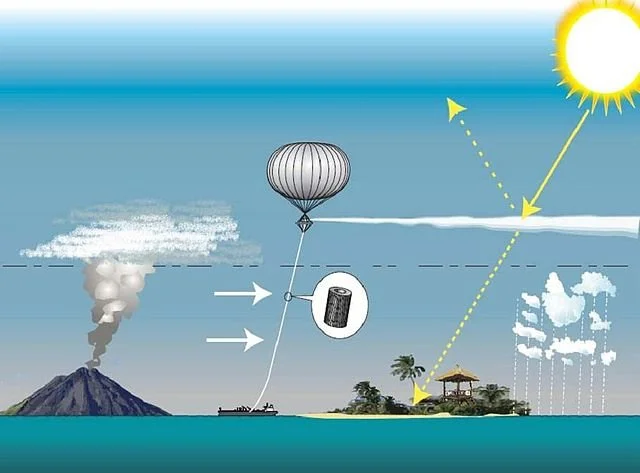
David Warsh: Will geoengineering be needed to stem global warming?
Proposed solar geoengineering using a tethered balloon to inject sulfate aerosols into the stratosphere.
SOMERVILLE, Mass.
Of the three broad approaches to coping with the effects of global warming – reduction of greenhouse-gas emissions; various adaptations to a warmer world, and solar-radiation management – it is the idea of climate intervention, or “geoengineering,” as its enthusiasts often describe it, that engenders the most fear.
We know that the natural version works: Volcanic eruptions over the millennia have demonstrated that much. Volcanic dust spewed into high altitudes has reduced temperature over significant portions of the Earth’s surface in the past, by making the atmosphere more reflective of the sun’s rays.
But the idea of deliberately pumping sulfates into the stratosphere to reduce global temperatures appears to some so risky, if only by dint of the “not-to-worry” incentive it seems to imply, that some climate scientists – their opinions buttressed by Under a White Sky, the book and Snowpiercer, the film – have called for a ban any geoengineering research at all.
That would clearly be foolish. The good news is that Science magazine last month reported that the first cautious attempts to understand the Earth’s “radiation budget” have begun. Prodded by Congress, the U.S. National Oceanic and Atmospheric Administration has launched a program to understand “the types, amounts and behavior of particles naturally present in the stratosphere.” SilverLining, an interesting non-governmental lobbying organization, is also involved.
[T]the balloons and high-altitude aircraft in the program aren’t releasing any particles or gases. But the large-scalefield campaign is the first the U.S. government has ever conducted related to solar geoengineering. It’s very basic research, says Karen Rosenlof, an atmospheric scientist at NOAA’s Chemical Sciences Laboratory. “You have to know what’s there first before you can start messing with that.”
An appropriately cautious beginning. I don’t know how humankind will gradually solve the climate-change problem, but I am pretty confident that it will, through some combination of alternative fuels; massive adaptations, both physical and social; and, probably, some degree of geoengineering. I am reminded of the Christian hymn text that William Cowper wrote , in 1773, so apropos today that it is worth quoting at some length. A great deal has happened in those 250 years, of course, so feel free to substitute “Evolution” for “God,” if you prefer. It still scans.
God moves in a mysterious way,
His wonders to perform;
He plants his footsteps in the sea,
And rides upon the storm.
Deep in unfathomable mines
Of never failing skill;
He treasures up his bright designs,
And works His sovereign will.
Ye fearful saints fresh courage take,
The clouds ye so much dread
Are big with mercy, and shall break
In blessings on your head.
Judge not the Lord by feeble sense,
But trust him for his grace;
Behind a frowning providence,
He hides a smiling face….
David Warsh, a veteran columnist and an economic historian, is proprietor of Somerville-based economicprincipals.com, where this column first ran.

